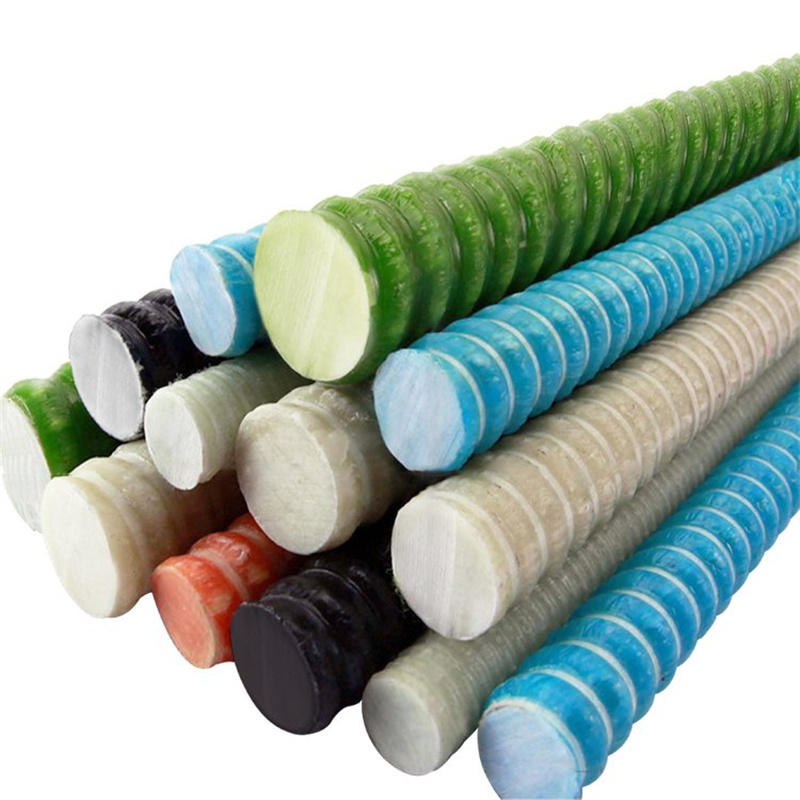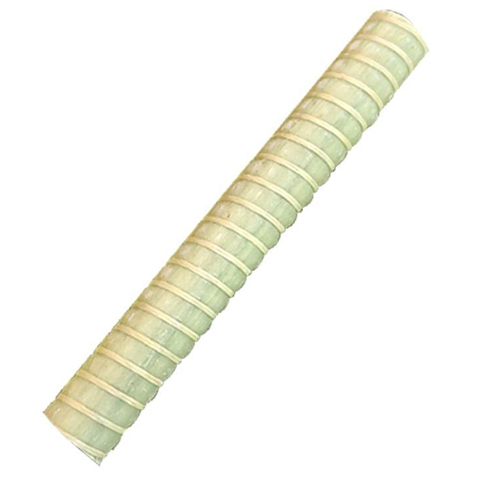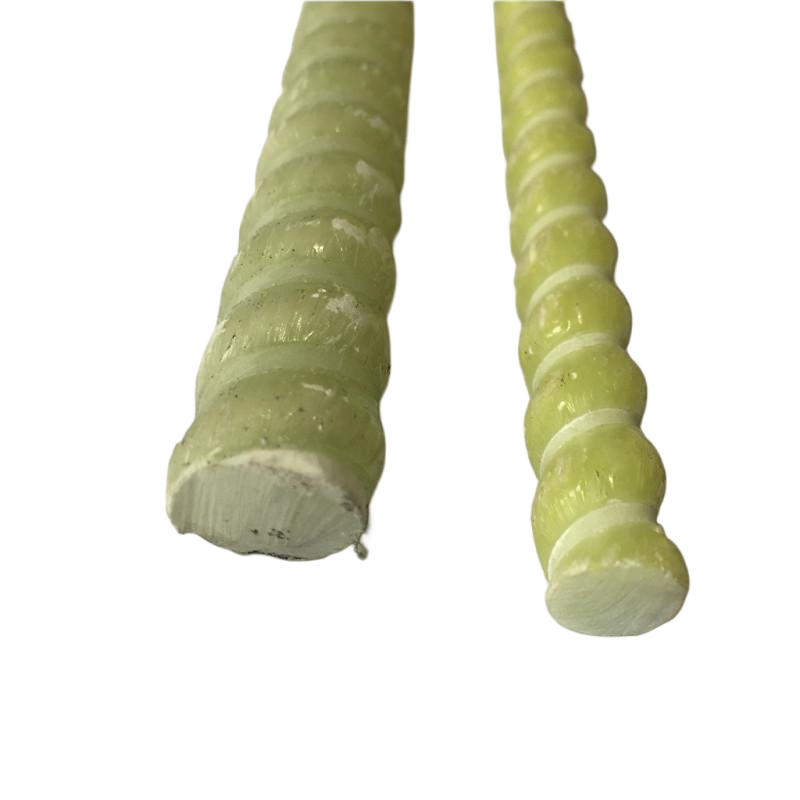Depth Analysis of GFRP Threaded Reinforcement in Glass Fiber Reinforced Composite Materials
1、 Essence and core characteristics of materials
GFRP threaded reinforcement is a composite material reinforced with glass fiber and resin (such as epoxy resin and vinyl resin) as the matrix, made by extrusion process. The surface is designed with full threads to enhance the bonding performance with concrete. Its core advantages include:
Lightweight and high-strength
The density is only 1/4 of steel bars (1.9~2.2g/cm ⊃3;), but the tensile strength can reach 500~900MPa (some products exceed 1000MPa), which is 1.5~2.5 times that of HRB400 steel bars.
Elastic modulus ≥ 40GPa, although lower than that of steel bars, deformation control can be optimized through structural design.
Excellent corrosion resistance
Resistant to chloride ions, acid and alkali, and seawater corrosion, suitable for corrosive environments such as chemical plants and coastal defense projects, with a lifespan far exceeding traditional steel.
Resistant to carbonization and freeze-thaw, reducing maintenance costs.
Functional diversity
Non magnetic/non-conductive: suitable for special scenarios such as nuclear power plants and medical MRI rooms.
Good thermal stability: The coefficient of thermal expansion is close to that of concrete, and the bonding strength is stronger.
Strong wave transmission performance: no demagnetization treatment required, suitable for facilities such as radar stations.
Construction convenience
Customizable shape and length, easy on-site binding, reducing labor intensity.
Lightweight, easy to handle and install.

2、 Application Fields and Typical Cases
Building reinforcement and repair
Bridge/floor reinforcement: enhances durability and load-bearing capacity, extending service life.
Restoration of historical buildings: providing structural support without damaging the original appearance.
marine engineering
Dock/offshore platform: resistant to seawater corrosion and salt spray erosion.
Breakwater: Resists seawater erosion and reduces maintenance frequency.
infrastructure
Roads/tunnels: Provide long-term stable reinforcement solutions to reduce settlement risks.
Water conservancy engineering: resistant to water erosion, suitable for scenarios such as dams and canals.
Special environment
Chemical area: resistant to chemical corrosion, protecting structures from erosion.
Electrolytic cell/sewage treatment plant: resistant to acid and alkali corrosion, improving equipment lifespan.
Green Building
Energy saving buildings: reduce material consumption and conform to the low-carbon trend.
Zero carbon buildings: help achieve carbon neutrality goals.

3、 Market Status and Development Trends
Market Size
It is expected that the global market size will reach 450 million US dollars by 2029, with a compound annual growth rate of 11.5%.
The Asia Pacific region (especially China and India) has the fastest growth in infrastructure demand.
Main producers
Mateenbar, MRG Composites, and other companies occupy approximately 56% of the market share, while domestic enterprises such as Sinoma Technology are gradually rising.
Driving factors
Policy support: Green building and environmentally friendly material policies drive demand.
Cost optimization: Improving production processes to reduce material costs.
Performance improvement: The application of high-strength and high modulus fibers expands the application fields.
Technology Trends
Low cost production: Developing continuous extrusion technology to improve production efficiency.
Performance optimization: Improve the elastic modulus (target above 50GPa) and develop high-temperature resistant resins.
Intelligent materials: Integrated sensors to achieve structural health monitoring.

4、 Standards and specifications
Appearance and size
Surface fully threaded design, with neat thread shape and no bubbles or cracks.
The nominal diameter is 10-36mm, and commonly used specifications include 20mm, 22mm, 25mm, etc.
The straightness deviation is ≤ 3~5mm/m (depending on the diameter).
mechanical property
Tensile strength: ≥ 500~900MPa (depending on diameter and process).
Elastic modulus: ≥ 40GPa.
Shear strength: ≥ 110MPa.
Ultimate tensile strain: ≥ 1.2%.
test method
The density test shall be conducted in accordance with GB/T 1463.
The tensile performance shall comply with GB/T26743.
The shear strength shall be executed in accordance with JG/T 406.
Application specifications
Excavation engineering: GFRP reinforcement is not used to support beam components, and underground continuous walls are only used for temporary support.
Mixed reinforcement: When there is a requirement for deformation control, GFRP reinforcement and steel reinforcement mixed reinforcement should be preferred.

5、 Future prospects
Intelligent Building
Integrated fiber optic sensors for real-time monitoring of structural stress and strain, enhancing safety.
Extreme Environmental Engineering
Applied in deep-sea, polar and other scenarios, utilizing corrosion-resistant and lightweight properties.
circular economy
Develop recyclable resin matrix to enhance material sustainability.
cost competitiveness
By scaling up production and technological innovation, costs can be reduced to within 1.5 times that of steel bars, accelerating the substitution process.

6、 Challenges and Countermeasures
Cost issue
The current cost is about 2-3 times that of steel bars, and it needs to be reduced through policy subsidies and large-scale production.
Connection technology
Develop specialized anchors and connectors to ensure structural integrity.
Long term performance data
Strengthen actual engineering monitoring, accumulate performance data for more than 20 years, and enhance market confidence.
GFRP threaded bars, with their unique performance advantages, are gradually evolving from "alternative materials" to "mainstream materials", providing safer, more durable, and environmentally friendly solutions for the engineering field. With the advancement of technology and cost optimization, its application prospects will become even broader.


























